Peter Cooper, Citizen Industrialist: a Biography Timeline--
by Robert E. Buxbaum
1791, February 12: Peter Cooper is born in New York City,
the third son of an overly kind grocer, John Cooper. John extends credit widely and is rarely paid back.
By the time Peter is 5, his father is bankrupt. John becomes a hat maker, and by age 7 Peter is working for him.
Cooper learns the love of charity from his father, but also learns the folly of extending credit, even to worthy people.
“Give a man a gift, but do not endorse his note”, Peter would later say.
1804 Peter is 13. He has apprenticed to his father in several trades, but found none quite to his liking, and none that his Father is sucessful at.
By 10, he has learned hat-making, by 13 brewing and brick-making, all alongside his father.
He will go on to learn carriage-making from John Woodward before building a business of his own.
At 13, Peter Cooper makes his first invention: a crank-operated washing machine that sits atop a barrel full of clothes and soapy water.
When the crank is turned, the device bangs the clothes with a ram while slowly rotating about the top of the barrel.
In New York, he begins a lifelong dislike of slavery after seeing two slaves forced to whip one another.
1808 Peter is 17 and apprenticed to John Woodward.
He learns to avoid gambling and smoking after spending $10 ( a great sum in those days) on a lottery ticket and a cigar.
The money iis mostly from the sale of a toy wagon he'd made. He does not win the lottery and gets sick on the cigar.
He calls this the best investment of his life, as the loss of this $10 stopped him, early on, from spending his money on "these vices."
Gambling debts will ruin his younger brother.
1811 Age 20, still an apprentice carriage maker, Peter invents and demonstrates a tidal-driven ferry in New York harbor.
He shows it to the Mayor of NY, and to Robert Fulton, the most famous inventor of the day.
The ferry operates on a continuous chain starting at the point of the current Staten Island ferry loading dock.
Power for the chain comes from air that has been compressed by energy from the tides at this point.
The Mayor is impressed; Robert Fulton is not.
Cooper makes it a point to treat young inventors better than he was treated when he gets older and becomes known as a prominent inventor.
He keeps a link from the chain in his desk as a reminder.
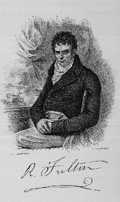
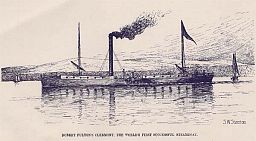
1812: Peter, age 22, is at the end of his apprenticeship. He is offered funding from his master to start his own carriage shop,
but decides not to enter the business after seeing a prominent customer default on delivery of an expensive carriage.
The customer had no money, but had pretended wealth for many years. The default bankrupts Cooper's master.
1812-1816: The war of 1812 rages, and trade with England is stopped.
Peter Cooper and his brother, buy the patent rights to manufacture and sell a cloth cutting machine in the state of New York "from a Quaker gentleman, at a very reasonable price.".
The machine appears to involve a steam engine driving a gillotine-like blade up and down through several layers of cloth at a time.
The machine sells well until 1816 largely because the supply of British cloth has been cut off due to the war.
Peter hires distribution managers throughout New York State, and hires a substitute to take his place in the army -- a common practice at the time.
Peter's business collapses after the war, as the US is then flooded with child-made British clothes.
Peter will come to prefer businesses that have a monopoly that is local at least.
In this, he presages the Austrian economist, Schempeter and the qualiy expert Edwards Deming.
Almost all current economists and most politicians appear to be anti-monopoly, and I (REB) find both sides of the argument equally convincing.
1813, December 22: Age 23, Peter Cooper marries Sarah Beddel. They will have two surviving children: Amilia and Edward.
Amilia will marry Abram S. Hewitt, a college friend of Edward's. Both Edward and Abram S. Hewitt will go on to be Mayors of New York, though from different parties.
Both will run steel businesses, and Hewitt will go on to become a congressman.
One of the Hewitt Children, Peter Cooper Hewitt, will invent the sodium vapor lamp, the plasma rectifier, plus several other devices including (it seems) freeze-drying.
1815, March 17: Age 25, The war of 1812 is over. Peter Cooper converts his cloth shear making business into a cabinet making business.
Peter Cooper's first patented invention is developed that year: a wind driven, self-winding
cradle. This cradle has a clock mechanism and a spring, similar to current cradles and
swings, but the spring is continuously tightened by a wind-driven ratchet and pall. Peter
makes and markets the invention, eventually selling the patent to buy a grocery store at
the corner of 8th street and 3rd Ave, the future sight of The Cooper Union Engineering Building.
Other “minor” inventions follow.
These include a small-bore, low dynamic mass steam engine and a continuous chain, steam-driven system to increase traffic on the Erie Canal.
Cooper puts the steam engine to use in his shop, and later uses it for his locomotve, The Tom Thumb.
The continuous chain system is rejected as it takes work away from horse-breeders and feed suppliers.
1818-1822: Peter Cooper runs his general store and grocery. He is successful but does not like the
grocery business. One Cooper innovation is to sell pre-sharpened axes at a time when most axes are sold unsharpened.
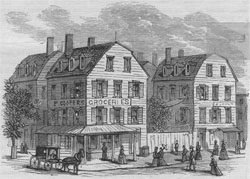
1820-1865: Age 30, Peter Cooper buys a glue factory from Mr. Vreeland in Kipps Bay (Grammercy Park) Manhattan.
Peter had bought glue from there knew the business to be a good one. He sells the grocery shortly thereafter to concentrate upgrading the glue factory.
He's nearly killed several times in this. As business expands he moves the glue factory to Burling Slip, Brooklyn and later to Maspeth, Queens.
In Maspeth, Queens, near Newtown creek, cooper builds the large facrtory shown in the picture below.
Peter Cooper invents the double boiler, a major innovation (see figure) that avoids burning the glue by heating it directly with a fire.
Instead, in the double boiler water is heated by coal fire, and steam from the hot water cooks the glue.
The double boiler is used to this day thoughout the food industry, and steam remains the most popular heat transfer fluid throughout the chemical industry.
Using the double boiler Peter Cooper's begins to make glue in ten, different, standard grades.
The lightest grade will be sold as edible gelatin as well as for glue use.
Cooper invents a method for freeze-drying glue and similar products, 1845. (need technical details -- how was this done in the 1800s?).
Quality control is an important part of Cooper glue.
Peter Cooper invents a vernier test for glue stiffness (see picture below); a weight is placed on a block of gelled gule, and one measures how far the weight sags.
His test method for testing glue stiffness will be used till the 1950s.
Peter Cooper's glue works also produces animal-fat based oils and chemical products.
Of particular importance is Neat's Foot Oil, a lighting and machine oil made from calves feet. It's comparable to whale oil, and is still in use today.
Peter Cooper invents American Isinglass, a brightener and clarifier derived from fish oil; it is cheaper than Russian Isinglass, used to clarify wine and deserts.
In 1865 Cooper retires from active involvement in the glue business. He sells the main factory and land to his son, Edward, his agent, William Serrell, and their children for $200,000.
At this point, the Glue Factory is probably the largest in the country, and perhaps in the world. It is selling approximately $200,000 worth of glue per year, with distribution from London to South America.
In the 20th century the glue works would leave Queens for Gowanda, NY. There reamins a small monument to the factory in Maspeth, Queens.
His Grandson, Peter Cooper Hewitt will patent an improved chiller table for gelatin making.
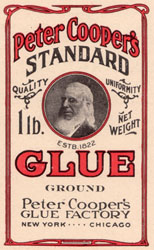
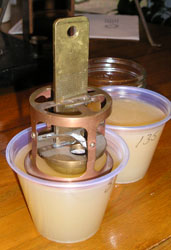
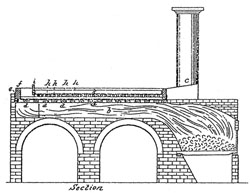

1828-1852: Age 38. Peter Cooper is elected to the Common Council of New York, this is the first of many government posts Peter will hold.
In this post, Peter brings clean water to New York (1835) by a long-distance pipe that traverses the Harlem river.
The idea isn't original to Cooper: he finds a farmer who's done the same thing on a smaller scale on his own farm, and uses the idea to bring water long-distance to New York city.
Peter cooper suggests, and is approved for the construction of a lake in central park to serve as a gravity-driven fire-resovoir in case othe pumps fail.
The lake is connected to downtown by a long pipe. Cooper, as head of the Common Coucil tries to bring professional police to New York, but fails.
He will push for professional civil cervice throughout his life.
Peter's last elected office is 1841, age 51. He will run for Mayor in 1845, and loose.
He will run for president in 1876, and lose. He will spend the last years of his life on several non-elected boards including the education board.
Peter Cooper, increasingly weathy, founds, or co-founds a variety of institutions for the benefit of New Yorkers: The New York Gallery of Fine Arts, 1845,
New York Sanitary Association (year?), and New York Asylum for Delinquents 1851. He serves on the boards of most of these institutions.
During these years, Peter Cooper is a staunch Democrat. He presides over Democratic party meetings in Tammany Hall until 1852, pushing regularly for honesty and good government
Through this period, he appears oblivious to the corruption taht surounds him. In 1853, cooper breaks with The Democrats and Tammany over slavery. He becomes a Whig.
1828: Age 38, Peter Cooper buys land in Baltimore and hopes to sell tracts at a profit.
After one year, he finds that his overseer has has done no work, and that he can not easily sell thes land as there is no easy transport into and out of the city.
Peter fires the overseer and hires an engineer to determine what he can do with the land.
The engineer suggests the iron business since there is iron ore on the land, and plenty of trees that can be used for charcoal.
Cooper enters the iron business. In this, he invents a process for rolling steel, and uses this process to make rails for horse-drawn trolleys.
Eventually he will make rails for steam railroads, and steel beams for the first skyscrapers.
His first steel I beams look like talls rails with a round top and a flat bottom, see the shape of the beams in the middle diagram below.
These beams are used in the Flatiron Building, the Philadelphia Mint, The Cooper Union, and the US Treasury building.
The Cooper Union used to give mounted sections of beam to individuals who doanted to the School.
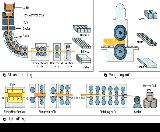
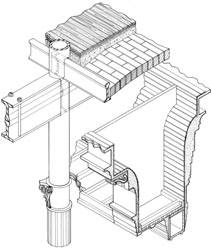
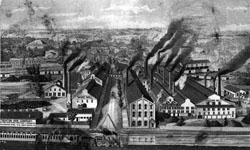
1830: Age 40. Peter Cooper builds and engineers the first practical steam locomotive made in America, The Tom Thumb,
as a demonstration for the stockholders of the Baltimore & Ohio Railroad. The demonstration
is a success; the B&O builds and operates steam locomotives of this design and opens Baltimore for settlement.
The first locomotive in America was the “Stourbridge Lion” (see below, right)
The Lion had been imported from England in 1829, but is too large and heavy (7 tons) to navigate Baltimore's hills or run well on the wooden tracks then available.
Cooper's friend col. John Stevens
had earlier built a smaller locomotive, but it lacked power and could only navigate a flat, circular track at his New Jersey home.
Cooper is certain he can do better. He designs and builds a locomotive that weighs 3 tons or less, but is as powerful as the much heavier Lion.
One innovation is that Cooper uses conical wheels on the locomotive and carriage, as opposed to the square wheels of the Lion.
This insures that the train leans into curves (as with the current Accela train, but at much less cost).
It also insures that the outer wheel moves fasster than the inner wheel when the train goes around a curve.
The effect is to insure the locomotive can move quickly while having a very small turning radius.
He builds a small, high pressure vertical boiler that operates with an anthacite coal fire and sends hot fumes up two, small, gun-barrel fire-tubes.
The trick to this compact design is that it has a forced-draf, unlike other designs, like the lion, that use free draft, much larger fire tubes and a much larger cylinder operating at lower pressure.
Hot air from the fire is forced through the tubes by a circumferential blower. This is the large horizontal cylinder in the pictures.
The fire-tubes were the barrels of two rifles that Cooper purchased and sawed off personally.
The Tom Thumb is the first locomotive to use a forced draft, an innovation that greatly increases the power/weight ratio of the engine.
Modern steam locomotives use suction from a steam-venturi to achieve the same effect.
The Tom Thumb incorporates a large gear that penetrates the floor of the engine carriage.
This gear acts as a flywheel moderating the speed of the one-cylinder steam engine.
The engineer pushed with his foot on the gear to start the train from a dead stop and to reverse direction.
This is different from the Stourbridge Lion, which had two cylinders, offset by 90 degrees.
The Tom Thumb does not need to be turned around, as such.
Instead, based on which direction the engineer pushes the gear at the start, the engine will run either forward or backward.
On the return trip, the Tom Thumb will push its carriage rather than pull.
When running this way, cinders from the boiler will not fly back and annoy passengers.
The Tom Thumb (with Peter at the throttle) raced a horse and would have won had not the belt slipped from his air blower.
His race with the horse-wagon appears on B&O stock certificates.
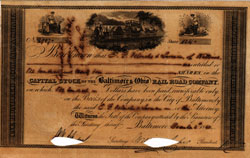
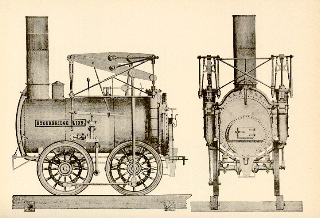 .
.
Based on the gearing and the speed during the race (about 10 mph), I calculate that the gear and the steam engine operated at about 150 rpm:
This is faster than the river-boat steam engines of the day, but about the rpm of modern steam engines.
Based on the small bore of the engine (3/4" x a nearly 2' stroke), and the horse-power (I estimate about 2 hp),
I calculate that the steam pressure must have been about 150 psi.: somewhat higher than the norm of the day.
Peter increased the pressure for the race by holding down the safety valve using a piece of iron wire that he pulled with his hand.
Cooper used a narrow bore cylinder, believing (correctly, I think) that he saved kinetic energy this way.
He imagined that the kinetic energy of the piston was lost whenever it reversed direction.
Later authorities claim that any kinetic energy loss of the piston goes to the flywheel, but
I do not believe they are right except for the ideal case of frictionless bearings.
The piston and boiler of the Tom Thumb are vertical to save space in the carriage.
Peter Cooper does not realize at first, that the Tom Thumb will gain him more notoriety than all his other endeavors.
He does not go into the locomotive business, nor does he patent his idea for the use of forced air in locomotive boilers.
Perhaps he does not realize how important this idea is. He can not patent the idea for conical wheels, as this came from someone else, a Mr Knight of the B & O.
Cooper is careful to give Mr. Knight credit for the idea -- one that would seem to have value today.
Contact buxbaum@rebresearch.com for a copy of detailed plans for a working model of the Tom Thumb published in 1929-30 for the 100th anniversary.

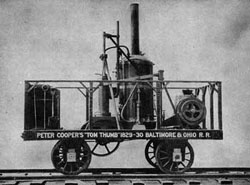

1831-1871 Age 41 to 81. Cooper's steel business grows; he forms the Trenton Iron Works to make iron and steel in New Jersey from local ore.
His steel is used in the Dome of the Capital in Washington, DC, and will be used in the transatlantic cable.
Peter heads the education board of New York. Travels around NY with an inflatable seat cushion ring to cushion his rear while visiting classes.
The ring was made by Charles Goodyear, a friend and fellow inventor, pictured right next to Peter in the “ Men of Progress” painting.
A ring of this sort, and perhaps the historic ring itself, is behind the bar at McSorley's Ale House Saloon, near the cash-register.
It sits upon "Peter Cooper's chair." Presumably Peter Cooper was a regular at McSorleys.
Peter comes to believe that religious education of the era is training tribes to fight one another, and not act civily, nor think on their own.
He sees flaws in the higher education, too saying that a Harvard or Yale education “teaches everything about work, except to do it“;
he develops ideas that will appear in the Cooper Union charter, but he is not particularly succesful at preventing religious schools from getting government funds to teach the things he deplores.
Boss Tweed's power stems, in part, from his practice of directing state funds to religious education.
It appears Cooper was not anti religion despite quotes to the effect that God's intent can be found in science. Cooper quotes scripture and attends services at the
essay by the Unitarian Universalist Association.
An early trustee of Cooper Union is William E. Dodge, a promoter of religious education.
1835 to 1853 Cooper is involved as an inventor, investor philanthopist. he becomes a major investor in railroad stock and bonds.
These are often acquired in trade for railroad steel. Cooper develops and demonstrates the first remote controlled torpedo.
This is an above-surface steam-boat, loaded with explosives, the rudder is conrtrolled by two cables from the shore. Cooper
hopes it will put an end to the German-Turkish war then raging.
Invents a machine to grind and polish glass, steel, and other surfaces to a true and perfect surface, 1835.
He patents an improved process for iron making where anthracite coal is directly puddled with the iron ore, and air is added directly from pipes to heat the mix.
he sells rights to use this process for $200 plus a 20% commission. By 1843 he has sold these rights to every major iron maker in New England.
In giving gifts to his children and grandchildren, Cooper gives tools rather than toys.
1843 Cooper's iron-making patent is challenged by Von Faber of Germany based on a similar process invented there. Cooper wins the patent fight.
Insead of pushing off Von Faber, he gets him to combine their patents and so split the licensing profits for a better process.
1845: Age 56, Peter invents and patents gelatin desert, currently known as Jell-O.
This is, essentially, a freeze-dried version of his lightest weight hide-glue, made without the preservatives he'd begun to add to his regular glue.
Both freeze drying and adding preservatives were Peter Cooper innovations.
The freeze drying patent is filed after Peter Cooper's death suggesting that Peter Cooper Hewitt was a major co-inventor.
Recipies from Peter Cooper's wife, Sarah, appear on early packages of gelatin.
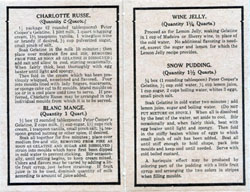
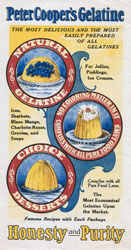
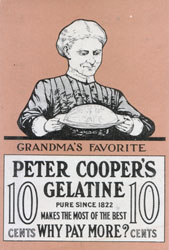

1845 Age 56. Peter runs for Mayor of New York, and loses.
Both son, Edward Cooper, and son-in-law, Abram Hewett will hold office as Mayor of New York.
Edward Cooper ran in his father's shadow, as an anti-Tammany Republican and "Greenback."
His tenure will be marred by claims incompetence in the fight against Tammany corruption, as the cartoon at right suggests.
Note Peter Cooper's glasses in this picture and most others; he made them himself.
They are a new type of bifocal where the second lens is on hinges at the side of the first lense until needed.
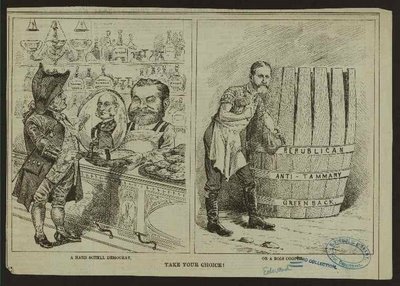
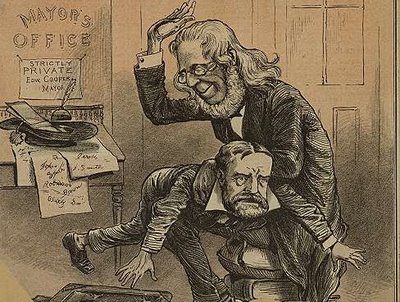

1854-1860: At age 65 Peter Cooper establishes and begins to run The Cooper Union for the Advancement of Science and Art, an educational institution, modeleded in part on the Rensselaer Institute and The Ecole Polytechnique in Paris.
The aim as described in Harpers weekly, March 1861, is for "the instruction and improvement of the inhabitants of the United States in practical science and art". That is, "the application of science to the useful occupations of life, " education at a higher level than taught at trade-schools, but with an emphais on useful as opposed to the "better" schoools of the day. Cooper Union emphasizes night-time and part-time education, is free-of charge for all serious students. It has no lectures or courses of religeous outlook. Instead, there is an open librarty, the first in the United States, and students are encouraged to make up their own minds based on reading and attendence at lectures at the Great Hall, the largest hall of the day. Early speakers at the Great Hall include Abraham Lincoln, Redcloud, Susan B. Anthony, and Mark Twain. Cooper Union's name reflects the Union struggle of the impending civil war, as well as the aim to provide a Union of the Sciences and Arts. The charter of Cooper Union forbits its combination with any religeous institution, a provision that will prevent it from joining Columbia University during a dark financial period. Cooper Union is the first private college to admit Jews, Blacks, and Women. The experts of the day assure Cooper that such individuals are too stupid to teach, but Cooper has seen them learn in trade schools and trusts otherwise. Princeton University will admit its first woman student in 1967.
More information about Cooper Union and its history can be found at The Cooper Union website.
Early part time alumni include Tom Edison, Felix Frankfurter, and August Saint Gaudens.
St. Gaudens's father had made shoes for Cooper. St. Gaudens's statue of Cooper (1897) now stands in front of the building.
Edison will develop the iron-sulphate chemistry responsible for his stock ticker in the Cooper Union laboratories.
Eventually he builds a laboratory of his own in W. Orange, NJ. I know nothing about Frankfurter's time at CU, and would appreciate info.
In 1882, Peter Cooper said of his university, “I trust the young will here catch the inspiration of truth in all its native power and beauty
and find in it a source of inexpressible pleasure to spread its transformed influence throughout the world.”

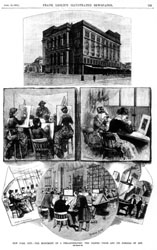
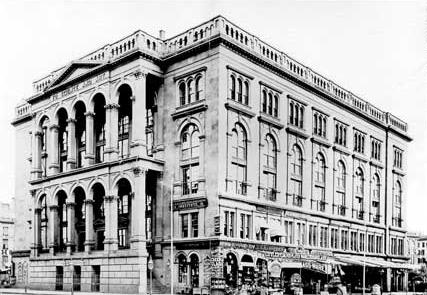
1854-1876: First Elevator Shaft (15 years before first elevator, see photo looking up). The shaft is still in existence at Cooper Union; as seen in the picture, the shaft is round.
In the late 1870s, the shaft got a square elevator after the Otis Brothers developed one that appeared safe. In 1976, during a restoration of the
Foundation building of Cooper Union, Architecture dean, John Hejduk (a Cooper alumnus) installs a round elevator in the shaft. It is specially-made by Otis Corp. Anothe Cooper innovation is sand-buckets placed throughout the building to put out gas fires. In those days, lighting is from coal gas or oil lamps, and fires are common. Cooper puts out a gas-fire himself using a sand bucket, switches the school to oil ligting, and promises to rip out the gas pipes himself. Abram S. Hewitt, a long-time friend of Edward Cooper, marries Amelia Cooper (1855). Hewitt is a Tammany Democrat. He will become mayor, US Representative, and the head of the national Democratic Party. The first years of the school also see controversy over the guidance of students, called “amorphous, preposterous, and impractical,” over education of Jews, Blacks, and women, and over the education of the different classes, races and sexes together. Others controversies concern a global property tax abatemet for the school that extends to a group of shops on the ground level. Financial support for the school includes rent from the shop-keepers who pay no property tax to the city. Over the years, many non-profits will benefit from similar tax-free museum stores and the like, but the practice remains controversial. The Village Voice regularly rails against Cooper Union for this (though not against other similar orgaizations), pointing out that the student engineers, architects, and artists are disproportionally white and oriental. While the Great Hall lectures are open to everyone, classes, shops and direct instruction is open only to those who pass a test of competence and demonstrate good moral character. Such restrictions were (and are) controversial; Cooper said he could not afford to take everyone in his school. He was compelled, he said, “to see hundreds go away with tears in their eyes for want of room and means to provide teachers for them.” Several of Peter Cooper's friends take up the challenge and build similar schools, each to his own tastes. Among the friends who do this were Ezra Cornell (1865), Matthew Vassar (1865), Edwin Stevens (John's son, 1870), Cornelius Vanderbilt (1873), Charles Pratt (1887), and Andrew Carnegie (1901). Most of these individuals start their schools after their deaths. Cooper is the only one to do this while still relatively young.

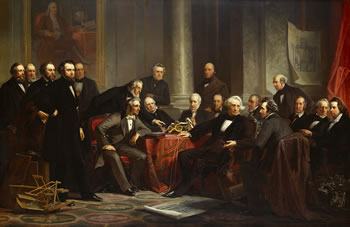
1857 Age 68. Peter Cooper buys the North American Telegraph Company.
Eventually this will became the core of AT&T.
He buys and applies a heterodyning patent invented by a music teacher to allow several telegraph messages to travel on the same wires.
This is accomplished by having the dots and dashes of different messages transmitted at different tonal frequencies.
He aims for a time “when knowledge will cover the earth like water covers the sea.” Isaiah 11;9.
1858-1877: Cooper is in his 70s and 80s, involved in telegraphy and running Cooper Union.
At age 69, he puts together a consortium of friends, to finance the New York, Newfoundland and London Telegraph Co.
The consortium includes Alexander Bell, Cyrus Field and Samuel Morse.
Peter Cooper is the principal investor: his North American Telegraph company owns more than 50% of the shares in the new company.
It's aim is financing Cyrus Field's attempts to lay the first Transatlantic Cable, but it does so only after acquiring 50 year monopoly rights to transatlantic cable transmission.
After several failures, the cable is a success and provides a profitable monopoly of telegraph communication
for the America Telegraph Co.
A major breakthrough comes from the use of guta percha, a newly discovered natural polymer produced by The Guta Percha company.
Guta percha is durable and a better insulator than any available to that point.
It is applied seamlessly to cover the copper and steel wire drawn by Peter Cooper's iron works (see section drawing below).
Also important are new cable laying techniques requiring a dedicated cable-laying ship, and the grim determination of Peter Cooper who financed most of it.
Early transatlantic telegrams cost $1. An excellent history of laying the
transatlantic cable is found on-line at atlantic-cable.com.
In the painting below are shown the principal members of the company: 1= Peter Cooper, president; 2=David Field; 3= Chandler White, secretary;
4 =Marshal Roberts; 5= Samuel F.B. Morse, vice president; 6= Daniel Huntington; 7= Moses Taylor, Treasurer; 8= Cyrus W. Field; 9 = Wilson Hunt.
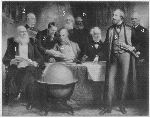
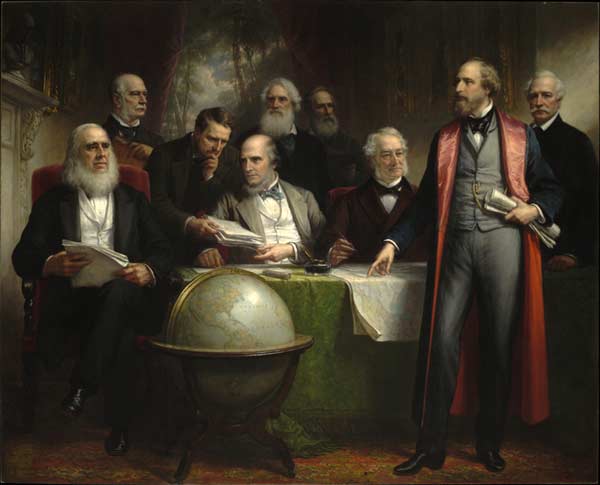
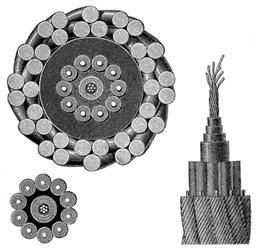
1861-1865 Civil War years. Cooper's mills makes cannon and gun-metal for the war --
particularly heavy naval cannon and the Trenton-Springfield rifle, many of which were stamped U.S. Trenton.
Cooper hires a dozen substitutes to serve for him in the army (still a common practice), and is the first to buy war bonds.
Endorseses Chase's idea to issue fiat currency, greenbacks, but does not like that it is irredemable in anything.
Suggests that greenbacks should pay interest, like a bond, or at least that they should be redeemable against taxes.
These ideas will return later, when Cooper runs for president on the Greenback party.
Early in the war, Cooper suggests that the Union should purchase all the slaves and free them.
Later, he gives up that idea and favors an all-negro army corps to fight in the war.
The war causes his final break with the Democratic Party, and with the Whigs. Cooper supports Lincoln in both elections.
Cooper is involved in running Cooper Union, laying the transatlantic cable, and running the glue and iron works.
He remains ignorant of Tweed corruption.
During this period, Cooper misses the opportunity to buy Wisconsin Iron mines from John Rokefeller.
Ore from these mines will allow Carnegie's mills to swamp his iron business in 20 years.
Cooper misses an opportunity to license the Bessimer process or Bell's telephone patents.
He tests the Bessemer process in Trenton, and (I presume) is unimpresed. Cooper buys Ringwood manor, complete with an
iron ore mine and small forge. Part of the attraction is iron ore: he hopes to make steel there.
He builds a continuous chain mining and steel operation there so that ore can be brought directly from the mine to the mill.
The design seems advanced, and Thomas Edison will try something similar in the 1900s, attempting to make steal cheaply in New Jersey.
Neither mill is very successful. Cooper ends up using the manor area as a family home and retreat.
In the eaarly 1900s the manor and grounds are donated to Cooper Union as the Green Engineering Camp.
The State of New Jersey will take it over in the early 1970s after cancelling its tax-free status.
A fine history of Ringwood manor and its occupants can be found at Ringwood manor.com
Cooper speaks at the opening of the Vassar Female College, 1865.
Vassar was a friend of Cooper's and this appears to be one of the first colleges inspired by Cooper Union.
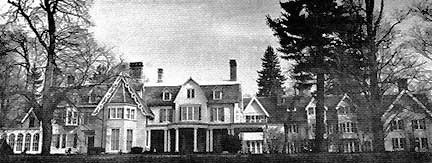
1866-1867: On Hewitt's advice, Cooper turns down an offer to sell the Iron works to Andrew Carnegie.
He divides the iron business in two. The main shop, The Trenton Iron company, is put under the management of A.S. Hewitt, his son, William Hewitt, and James Hall.
Cooper organizes a new business, New Jersey Steel and Iron with his other son, Edward Cooper, as president.
Cooper continues to provide loans and occasional management.
Brings Siemens' steel -making process to the US. This steel, for a time, competes with Bessemer's steel.
Will banter with Hewitt that the money he'd made on the Iron works since 1867 did not match the interest he would have received on the value of a sale to Carnegie.
Hewitt tries to correct this as manager, but never can.
This joke, may express one of Cooper's fundamental benchmarks for good business management:
sell a business if the dividend-profit to the stock-holder does not exceed the interest that could be made selling the business as a whole.
In later years, this will be called the Dow Theory of investing.
Cooper tries his hand at refigerator design.
He also tries the use of the refrigerant, carbon disulphide (CS2) as a substitute for steam in steam engines.
Carbon disulphide works better as a refrigerant than as a power generator.
Cooper patents a procss for making commercial buckskin by beating oil into hides using steam hammers (the traditional method for making buckskin was to have a squaw chew the leather to soften it.)
Cooper tries to patent a plan to increase traffic on the Erie canal by adding salt to the water to increase its buoyacy.
The patent examiner rejects this as "the most far-fetched idea ever conceived of by the mind of man."
It strikes me that there is an advantage to this idea that the examiner may have missed:
salt water freeses at a lower temperatuer than sweet water. A salt-water canal would have been open for more of the year, increasing business significantly.
Cooper intended to have the salt enter the canal at salzburg in the center of the canal, and intends to refine it for sale at the two canal end-points.
Although he remains a Republican, and a vocal force for good government, his son in law is a prominent Democrat.
Neithe of them appear recognize the corruption that stems from Boss Tweed and Tammany Hall.
He proposees A Charter for New York City that would increase the independence of New York City managers and contractors,
while requiring strong oversight and providing for their removal for corruption or incompetence.
Charter passes to the extent that it gives city managers freedom;
the oversight provision is voted down by the state legistlature.
Cooper does not suspect that Boss Tweed had bribed the majority of the legistlature.
Over the next few years, Tweed and his gang will steal approximately $200,000,000. under the cover of this charter.
The governace specified in Cooper Union's charter is similar to that in the original Charter for New York.
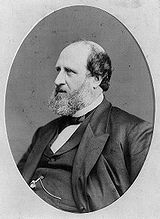
1865-1876 Cooper and Hewitt oversee Cooper Union's attempts to be a free and open forum, dedicated to tolerance.
Cooper Union becomes a hot-house for social change. The NAACP is chartered there, as is the Red Cross.
The Greenback Party and the quite revolutionary Knights of Labor have offices there.
Chief Red-Cloud speaks there. Anti-marriage, stockbroker-sufferagette, Victoria Woodhull speaks ther twice;
Clara Barton and Susan B. Anthony have their offices there (Peter Cooper insists that there be rooms set aside for women's activities).
Edward becomes mayor, but a New Charter is approved that gives him little power.
Peter Cooper himself begins to believe Industrialists have too much power.
He pushes for regulartion of Interest rates (anti usury laws, in modern terms).
He pushes for regulated monopolies for necessities like food and glue, but not for luxuries like phone calls and steel.
Most other industriaists of the time are pro-monopoly without regulation. This will remain the patern into the 20th century.
Cooper remains quite paternalistic: he gives raises to workers who get married, for example.
Perhaps because of the intereest in rewarding individual workers, his iron works avoids the labor unrest that shakes other industrial businesses of the day.
In 1871, for his 80th birthday, Peter Cooper donates $100,000 to his Cooper Union for the first open stacks library in the country.
Cooper says it is “for the use of workers and mechanics”. A copy of the Men-of-Progress painting hung in the library for some years.
Benjamin Franklin's library, though older, is a subscription library, open only to its subscribers.
The library is located onthe 3rd avenue side of the CU Foundation building.
Cooper is distressed by the large amount of theft the library endures, but continues to support it.
For his 90th birthday, he will donate a lighted clock for the front.
It will be the largest in the world until surpassed by the clock tower of Parlement, where Big Ben resides.
Carnegie will endow a larger open-stack library at 42 St. After Cooper's death, the CU library wlll cease to be open stack.
1876-1877: Peter Cooper, 85, runs for President on The Greenback party. The Party platform includes redeemable paper currency, women's
rights, high tarrifs, controlled interest rates, and welfare reform.
Cooper believes that the recession of 1876 can be reversed by monitizing the greenbacks, paper currency used to pay Union soldiers in the Civil War.
At the time, US currency is backed by gold, the greenback is backed by nothing, and is thus nearly worthless.
Cooper believes you can not have two US dollars with different values.
His stump speeches state that the major cause of the recession, and many others, is the change in the value of money that causes a home or factory
bought on credit, to sink to become worth less than the amount remaining on the debt.
He says this virtually guarantees that people will leave their homes vacant causing themselves to be homeless, while causing the the banks to go bankrupt.
These statements make sense to me, but are considered unusual at the time.
The New York Times lauds Peter Cooper's charitable intentions, but calls him “a loose money man.”
The NY Herald says Cooper should stop talking of finance, of which he knows nothing.
His friend, Stevens points out that Greenbacks are now owned by millionare speculators, not by Union soldiers.
Other industrialists oppose his financial ideas as inflationist (they were intended to be), and thus damaging to capital.
Cooper claims the monitary policy of the time is deflationary, and says his approach will not lead to general devaluation as the amount of currency monitized is limited by the amount of Greenbacks printed.
In his campaign, Cooper is anti labor-unions, but not anti labor. Says the unions force “ employers to pay as much for a poor workman as for a good workman.”
he suggests that workers, instead
“ ... should combine their capital and labor to carry on the different mechanical and agricultural employments on their own account and take the entire profit to themselves and their country.”
This will be a rally for the Knights of Labor. Cooper volunteers to invest and often does.
Cooper is for temperance but against prohibition;
He has “ little faith that a law will accomplish what the moral nature could not.”
After a hard election, the Greenbacks get less than 1% of the vote. Cooper is shocked by how poorly his party did, but
his ideas will resurface in later populist attempts to end recesssions.
Some of these later attempts are inflationist, proposed by “loose money men” hoping to manipulate capital to get elected.
Others seem to hugh more to Peter Cooper's original doctrine, hoping to end recesssions by monitizing bad US debts only, but not giving Washington an open check-book.
Current efforts to end the 2008-09 recession by monitizing Fannie Mae and Freddie Mac debt seem in line with Cooper's original ideas, in my humble opinon.
See the following for Greenback Party planks.
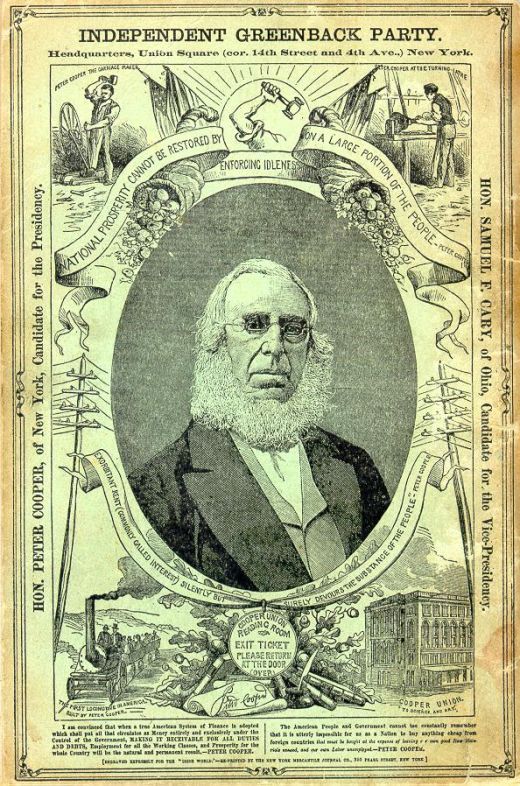
![greenback party platform sheet]()

1878-82 Known as Father Cooper, attempts to start another college, the Cooper-Limestone Institute, to help freed female slaves and other non-sectarian worthies in the South.
An early idea was to teach them to make lime and of hemp rope.
This college was not financially sound, though Cooper Union was not either at the time. Both schools require regular cash infusions from Cooper to meet their budget.
Other Cooper charities include an inventors' institute that Cooper funds.
The institute rents space on the ground-level of Cooper Union and eventually becomes profitable.
It buys patent rights to inventions, showcases them and tries to license them -- an idea that remains profitable to this day if the buyer has a good eye for such things.
Peter Cooper Hewitt (a grandson) invents the mercury vapor light and sodium vapor light.
Cooper-Hewitt invents a plasma rectifier, sells patent to Westinghouse as a way to produce high voltage DC current.
For the 3rd Ave Elevated train, and other eleveated lines, Cooper pushes for propuslsion by an endless chain instead of independent locomotives.
He says it is less dangerous and more efficient than having a locomotive start and stop. Further, he points out, with a central power plant there will be no cinders raining down
from above. Although his friend, Cyrus Field owns the NY Elevated Railroad Corporation, Field uses steam locomotives.
A cable tram system is built in San Francisco, though, and operates successfully to this day.
Cooper patents a break-energy recovery means for use on city trains -- his method involves putting the stations track at a higher level than the surrounding track.
Brake energy thus goes, in part to lifting the train. This energy is recovered when the train leaves the station.
This method is used occasionally (see picture of Cooper and Field below).
Peter Cooper speaks regularly at Cooper Union. Students are mezmerized by his combination of kindness and success. He is called First Citizen of New York when asked to reassure the
city after Garfield's death (1881). He sends political and financial advice to C.A. Arthur.
He writes a monograph "The Dangers of a War of Commerse."
He favors high tarrifs, especailly with Brittain, who he accuses of using child labor,
and of trying to undermine the US commerse as they had India's. Gandi would later take up this theme as a justification for cutting off trade with England.
Though still a member of the high-tarriff, US Board of Trade, he now blames businessmen as much as congress for maintaining a gold standard.
He now backs the wide use of fiat currency, greenbacks essentially.
One Cooper proposal is to monitize US debt so that one could use a US bond like cash for all purposes without having to sell or redeem it.
He blames the lack of adequate currency for the wide-spread poverty he sees.
Pushes for the US to provide major public works, through a Civil Service. within 5 years this comes into being. Pushes for the US to give away land in the west.
Oklahoma land will eventually be given away free.
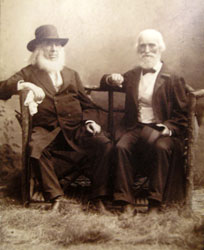
Cooper backs a Transpacific cable, backs Ferdinand Lessep's attempt to dig a Panama canal, funds production of a paddlewheel
steamboat with the paddles horizontally underwater (think Roots blower).
Cooper buys many patents, but only a few of these prove profitable. One succes is an adjustable arm for shutters and shutter windows.
It is still used to this day.
In 1882 Peter Cooper becomes vice-president of the Anti Monopoly league.
This group pushes that “ corporations, the creation of the state, should be controled by the state. ”
He favors the beakup of the more rapacious monopolies and favors regulated monopolies for basic goods.
Though these proposal seemed radical at the time, Theadore Roosevelt will enact some of them.
Taft will go further and will apply anti-monopoly theory to stop collaboration between the Iron businesses of Cooper's and Hewitt's grandchildren and John Roebling's Sons'.
US Steel is not regulated.
In modern times, there is a debate concernign the extent that regulation is needed to control the price of basic goods.
Most economists are against governmental control on theoretical grounds, but a review of history in the early 20th century might suggest otherwise.
In 1883 Peter Cooper publishes a book of his thoughts on politics and ilfe,
“Ideas for a Good Government”, available on line through the yamaguchi institute.
Of particular interest is Cooper's analysis of the sources of wealth and the causes of recessions, summarized above.
In early 1882 Cooper dictates his autobiography to Ella Fawcett, a woman educated in stenography at Cooper Union.
A link to the biography is found below. It includes the following thought near it's end:
"A long life has compelled me to believe that science is the rule or law of God by which the movements of the material creation are rendered intelligible to man;
that science itself is nothing more than the knowledge of this law or rule, actually demonstrated by the experience of mankind.
"Believing this, I have given the labors of a long life to the advancemtn and diffusion of scientific knowledge,
feeling assured that when Christianity itself is felt in all its purity, power and force, when it is relieved of all its creeds and systems of human device,
it will be found to be a simple system, science or rule of life to guide and regulate the actions of mankind."
April 4, 1883: Peter Cooper, 92 years old, dies after saying farewell to friends and leaving instructions for Cooper Union.
He is buried in the Greenwood cemetery April 7, after his body is viewed by 15,000 visitors.
The satirical magizine, Puck, crowns him with a civic crown a week after death.
Abram S. Hewitt continues to run Cooper Union, but can not run the Cooper-Limestone Institute as well.
Seven years after Cooper's death he turns it over to the local Baptists who make the place white-only, and Baptist-only.
One hundred years later, the Institute is run more the way Peter Cooper would have hoped.
In 1897
J.P. Morgan, a Cooper Trustee, donate his tapestry collection to Cooper Union.
In the same year, Peter Cooper's granddaughters found a museum of deseign at 90th street in NYC.
A.S. Hewitt donates the land under the Chrysler building to the Cooper Union;
this becomes a major source of funds for the school, but remains controvercial as the land is tax-free, though used for commercial endeavors.
New York will repudiate this practice, but leave Cooper Union's exemption grand-fathered in.
More information about the Cooper Limestone Institute can be found at Petercooper.info

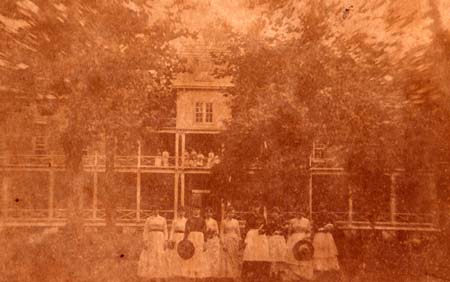
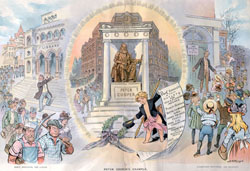
References include Peter Cooper's autobiography, Ed Mack's biography, B&O stock certificate,
the founding documents for cooper Union, petercooper.info, atlanticcable.com, ringwoodmanor.com, Wikipedia, Engineering model of Tom Thumb,
New York Times articles of the day, information from the Jell-O company, and from AT&T, and a set of
essays published as part of Peter Cooper's run for president.
(c) Robert E. Buxbaum, 2009, 2011. Robert Buxbaum is an alumnus of Cooper Union, 1976, and of Princeton University, 1981. He is president of REB Research and Consulting,
a maker of fine hydrogen purifiers and generators,
located in Metro Detroit, Michigan. A short Robert Buxbaum CV is found on the company website.
He (I) can be linked to through LinkedIn.
Historians, CU alumni, and friends welcome to link.
Be good or Begone.
Project started as a 5th grade assignment for Aaron M. Buxbaum now 20.
[REB Research & Consulting co] [Robert Buxbaum] [
Contact Info.] [
Hydrogen Links]











 .
. 
























